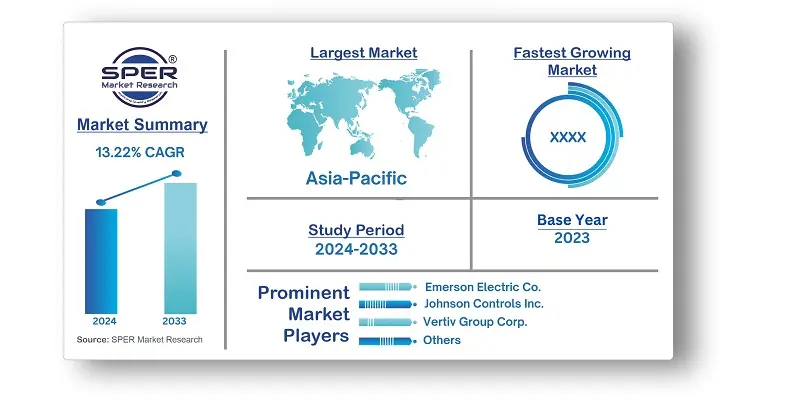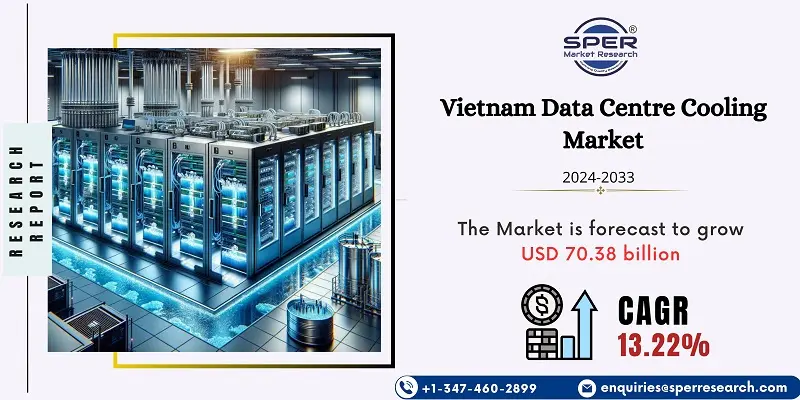
Vietnam Data Centre Cooling Market Trends, Share, Size, Demand, Revenue and Future Outlook
Vietnam Data Centre Cooling Market Growth, Size, Trends Analysis- By Cooling Technology, By Type of Data Centre, By End User- Regional Outlook, Competitive Strategies and Segment Forecast to 2033
| Published: Nov-2024 | Report ID: IACT24187 | Pages: 1 - 106 | Formats*: |
| Category : Information & Communications Technology | |||
- In August 2023, cooling module manufacturer Asia Vital Components (AVC) intended to increase the size of its Vietnam production facility in order to satisfy the increasing demand from its American clientele. The business's Vietnam subsidiary, AVC Vietnam, runs a USD 50 million production facility on 10 hectares in the Dong Van 3 Industrial Park in Ha Nam province, which is close to Hanoi.
- In March 2023, LiquidStack revealed that Trane Technologies, an HVAC firm, will be making a sizable investment to further immersion cooling technology. The innovative liquid immersion cooling method developed by LiquidStack is a significant advancement in environmentally friendly data center cooling.


| Report Metric | Details |
| Market size available for years | 2020-2033 |
| Base year considered | 2023 |
| Forecast period | 2024-2033 |
| Segments covered | By Cooling Technology, By Type of Data Centre, By End User |
| Regions covered | Eastern region, Western region, Southern region, Northern region. |
| Companies Covered | Alfa Laval AB, Emerson Electric Co., Fujitsu General Limited, GIGA-BYTE Technology Co. Ltd, Johnson Controls Inc., Legrand SA, Schneider Electric SE, Vertiv Group Corp., Others. |
- Data Center Operators
- IT Managers
- Facility Managers
- HVAC Engineers
- System Integrators
- Energy Managers
- Telecommunications Providers
- Cloud Service Providers
| By Cooling Technology: | |
| By Type of Data Centre: | |
| By End User: |
- Vietnam Data Centre Cooling Market Size (FY’2024-FY’2033)
- Overview of Vietnam Data Centre Cooling Market
- Segmentation of Vietnam Data Centre Cooling Market By Cooling Technology (Air-based Cooling, Liquid -based Cooling)
- Segmentation of Vietnam Data Centre Cooling Market By Type of Data Centre (Hyperscale, Enterprise, Colocation)
- Segmentation of Vietnam Data Centre Cooling Market By End User (IT and Telecom, Retail and Consumer Goods, Healthcare, Media and Entertainment, Federal and Institutional Agencies, Other)
- Expansion Analysis of Vietnam Data Centre Cooling Market
- Problems and Obstacles in Vietnam Data Centre Cooling Market
- Competitive Landscape in the Vietnam Data Centre Cooling Market
- Impact of COVID-19 and Demonetization on Vietnam Data Centre Cooling Market
- Details on Current Investment in Vietnam Data Centre Cooling Market
- Competitive Analysis of Vietnam Data Centre Cooling Market
- Prominent Players in the Vietnam Data Centre Cooling Market
- SWOT Analysis of Vietnam Data Centre Cooling Market
- Vietnam Data Centre Cooling Market Future Outlook and Projections (FY’2024-FY’2033)
- Recommendations from Analyst
1.1. Scope of the report1.2. Market segment analysis
2.1. Research data source
2.1.1. Secondary Data2.1.2. Primary Data2.1.3. SPER’s internal database2.1.4. Premium insight from KOL’s
2.2. Market size estimation
2.2.1. Top-down and Bottom-up approach
2.3. Data triangulation
4.1. Driver, Restraint, Opportunity and Challenges analysis
4.1.1. Drivers4.1.2. Restraints4.1.3. Opportunities4.1.4. Challenges
4.2. COVID-19 Impacts of the Vietnam Data Centre Cooling Market
5.1. SWOT Analysis
5.1.1. Strengths5.1.2. Weaknesses5.1.3. Opportunities5.1.4. Threats
5.2. PESTEL Analysis
5.2.1. Political Landscape5.2.2. Economic Landscape5.2.3. Social Landscape5.2.4. Technological Landscape5.2.5. Environmental Landscape5.2.6. Legal Landscape
5.3. PORTER’s Five Forces
5.3.1. Bargaining power of suppliers5.3.2. Bargaining power of buyers5.3.3. Threat of Substitute5.3.4. Threat of new entrant5.3.5. Competitive rivalry
5.4. Heat Map Analysis
6.1. Vietnam Data Centre Cooling Market Manufacturing Base Distribution, Sales Area, Product Type6.2. Mergers & Acquisitions, Partnerships, Product Launch, and Collaboration in Vietnam Data Centre Cooling Market
7.1. Vietnam Data Centre Cooling Market Size, Share and Forecast, By Cooling Technology, 2020-20267.2. Vietnam Data Centre Cooling Market Size, Share and Forecast, By Cooling Technology, 2027-20337.3. Air-based Cooling
7.3.1. Chiller and Economizer7.3.2. CRAH7.3.3. Cooling Tower (Covers, Direct, Indirect and Two-stage cooling)7.3.4. Others
7.4. Liquid-based Cooling
7.4.1. Immersion Cooling7.4.2. Direct-to-Chip Cooling7.4.3. Rear-Door Heat Exchanger
8.1. Vietnam Data Centre Cooling Market Size, Share and Forecast, By Type of Data Center, 2020-20268.2. Vietnam Data Centre Cooling Market Size, Share and Forecast, By Type of Data Center, 2027-20338.3. Hyperscale (Owned and Leased)8.4. Enterprise8.5. Colocation
9.1. Vietnam Data Centre Cooling Market Size, Share and Forecast, By End User 2020-20269.2. Vietnam Data Centre Cooling Market Size, Share and Forecast, By End User, 2027-20339.3. IT and Telecom9.4. Retail and Consumer Goods9.5. Healthcare9.6. Media and Entertainment9.7. Federal and Institutional Agencies9.8. Other
10.1. Vietnam Data Centre Cooling Market Size and Market Share
11.1. Vietnam Data Centre Cooling Market Size and Market Share By Region (2020-2026)11.2. Vietnam Data Centre Cooling Market Size and Market Share By Region (2027-2033)11.3. France11.4. Germany11.5. Italy11.6. Spain11.7. United Kingdom11.8. Rest of Europe
12.1. Alfa Laval AB
12.1.1. Company details12.1.2. Financial outlook12.1.3. Product summary12.1.4. Recent developments
12.2. Emerson Electric Co.
12.2.1. Company details12.2.2. Financial outlook12.2.3. Product summary12.2.4. Recent developments
12.3. Fujitsu General Limited
12.3.1. Company details12.3.2. Financial outlook12.3.3. Product summary12.3.4. Recent developments
12.4. GIGA-BYTE Technology Co. Ltd
12.4.1. Company details12.4.2. Financial outlook12.4.3. Product summary12.4.4. Recent developments
12.5. Johnson Controls Inc.
12.5.1. Company details12.5.2. Financial outlook12.5.3. Product summary12.5.4. Recent developments
12.6. Legrand SA
12.6.1. Company details12.6.2. Financial outlook12.6.3. Product summary12.6.4. Recent developments
12.7. Schneider Electric SE
12.7.1. Company details12.7.2. Financial outlook12.7.3. Product summary
12.7.4. Recent developments
12.8. Vertiv Group Corp.
12.8.1. Company details12.8.2. Financial outlook12.8.3. Product summary12.8.4. Recent developments
12.9. Others
SPER Market Research’s methodology uses great emphasis on primary research to ensure that the market intelligence insights are up to date, reliable and accurate. Primary interviews are done with players involved in each phase of a supply chain to analyze the market forecasting. The secondary research method is used to help you fully understand how the future markets and the spending patterns look likes.
The report is based on in-depth qualitative and quantitative analysis of the Product Market. The quantitative analysis involves the application of various projection and sampling techniques. The qualitative analysis involves primary interviews, surveys, and vendor briefings. The data gathered as a result of these processes are validated through experts opinion. Our research methodology entails an ideal mixture of primary and secondary initiatives.



Frequently Asked Questions About This Report
PLACE AN ORDER
Year End Discount
Sample Report
Pre-Purchase Inquiry
NEED CUSTOMIZATION?
Request CustomizationCALL OR EMAIL US
100% Secure Payment






Related Reports
Our Global Clients
Our data-driven insights have influenced the strategy of 200+ reputed companies across the globe.




















